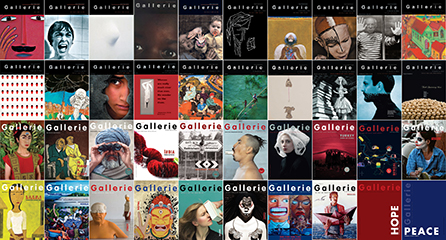It Is Ultimately Culture That Humanizes
Bina Sarkar Ellias (India)
Publisher, International Gallerie / ALFP 2007 Fellow
It was in early 1997 when the proverbial brick hit my head. A journalist-writer by profession, besides being a closet poet, I was co-running an advertising agency with my spouse as I’d just returned to India from Japan and did not have the confidence to get back into mainstream journalism. I was away for five years and was distanced from the current events of India of that period. There was no Google and no smartphones!
But the brick saved me, as advertising was an alien space and my discomfort within it got me thinking about doing something larger; something that would engage with people in a more meaningful way; something that would have to do with words and art, both of which I was passionate about; something in an eclectic form; something, above all, that would excel and allow for contemplation and discourse. Something that would be etched in readers’ minds and, hopefully, make a difference.
Thus, International Gallerie was born. And the first issue was launched in mid-1997. India had seen nothing like it then, as newspaper articles claimed. Large format, sumptuous production values, aesthetically conceived, with editorial material that shared ideas, issues that are of universal concern, and understanding and appreciation of cultural diversity; all of this interpreted through excellence in the wide and varied disciplines of the arts.

Fintan Magee. Location: Melbourne, Australia.1
Through Gallerie, I am able to share the learning I receive while researching each issue. Whether the issue is dedicated conceptually to an idea or to a holistic experience of a region, the key, almost a mission, is to have readers immerse themselves into the tactile quality and the thought-processes it lures you into. Through Gallerie, we have made critical interventions into race and caste issues, war, freedom and censorship, religion, India personal & political, gender issues, multiculturalism, migration, resistance, hope and peace, and also lyrical forays into poetry in art, art in poetry, rain, notions of beauty, celebration of books and others.
While entire issues have been dedicated to specific regions as seen through the lens of the editor, it is important that we do not fall into tropes. Therefore, going beyond the stereotypical perceptions of each region, I try to excavate the hidden, the curious, the bruises and the healings, the reasons to celebrate humanity.
These exigencies are navigated and featured through the powerful voices of the creative community of the world. Be it a visual artist, an architect, a designer, musician, dancer, theater-person, writer, poet, photographer or a filmmaker. Each of these significant entities of this earth has a space in Gallerie. A voice may express socio-political, cultural or philosophic ruminations. It may be a voice of protest or a voice that offers a new learning.

Thus, in twenty-one years of Gallerie, we have reaffirmed with every issue that cultural diversity is to be appreciated and respected. We have explored regions in the world as diverse as Kashmir and New York, Afghanistan and Great Britain, Palestine and France, Burma and Central Asia and Japan, amongst many others. What we have learned and shared with our readers is the rich heritage of each country, the cultural uniqueness of its people and their innate desire for an equitable and peaceful world. Most humans yearn for peace of mind besides the instinct for survival, but there are those who lust for more.

This lusting for more is our bane. More land, more wealth, more power has led to unabated violence and destruction; to more misery and a world besieged with regression and decadence.
The planet today is a cauldron of xenophobic paranoia. While this phobia serves the strategies of powers to exult on their thrones, it has reduced the “subjects” to robotic compulsions that George Orwell had prophesied in his forever masterpiece, 1984. The fictitious Ministry of Truth where Orwell’s protagonist Winston worked was, in fact, the Ministry of Lies which is our reality today; our current architects of the Ministry of Lies have crafted walls and boundaries with their bricks of hate; these are cemented with promises of bounty to those who align themselves with their evil conspiracies.
Religion and State have long been a nexus through zillions of orbits around the sun and corpocracy is wired to this dark sphere. Religion is no longer the sanctum of faith in spiritual practices and acts of humane behavior. Xenophobia continues to spill blood and divide people. In India, Hindu fanatics kill Dalits, Muslims, Christians and rationalists; in the United States white Christians attack persons of color; in Central and North Africa, Muslims and those of religious minorities are being persecuted; Burma Buddhists are attacking Muslims and Christians; in Malaysia there has been violent controversy over the term “Allah” being used by Christians. Israeli Jews have been colonizing and killing Muslim Palestinians; Muslims killing Christians in Nigeria—and other Muslims reborn as terrorists created by the United States. Why am I reiterating what you, my readers, already know?
Because there is a deathly silence amongst the masses of people who are not listening. It is as if we are numb with wars, hate-mongering and violence, atrophied and unable to stir ourselves into evolved, civilized humans; as if our sense of humaneness has been buried and burned in the cemeteries and pyres of apathy.
Before we become a global wasteland of compromised lost souls, let us pause and consider the present and future. As each day counts, each breath we take must be a resolve to turn things around. Each one of us must shed prejudices driven by the notions of nation, territory, religion, race, caste and multiple dogmas. Once these divisive factors are erased, a life-affirmative chapter will open. It can be done. There can be peace. It is ultimately culture that humanizes.
The contents of this article reflect solely the opinions of the author.



